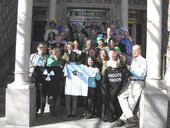Highlight
Internship Experiences Offer New and Opportunities for Trainees
Achievement/Results
Trainees of the National Science Foundation’s (NSF) Integrative Graduate Education and Research Traineeship (IGERT) program in Indoor Environmental Science and Engineering at The University of Texas (UT) each completes a one semester internship at a host institution. These internship experiences serve many purposes, including: (1) trainees are able to generate new ideas relevant to their dissertation research, e.g., by speaking with recognized experts in their field, attending seminars, etc., (2) trainees often work on interdisciplinary teams, thus gaining even more teamwork and interdisciplinary experience than that already offered in their IGERT program, (3) trainees are able to complete research using unique facilities at a host institution, and (4) trainees are able to make professional contacts that will serve them in the years after they receive their Ph.D. degree. To date, trainees have completed internships at Lawrence Berkeley National Lab (LBNL), National Institute of Standards and Technology (NIST), US Environmental Protection Agency (USEPA), Resources for the Future (RFF), the National Institute for Occupational Safety and Health (NIOSH), and the Texas Commission on Environmental Quality (TCEQ). This past year three IGERT trainees completed internships: Ellison Carter (Environmental Engineering), Matt Earnest (Environmental Engineering), and Sonny Rosenthal (Advertising).
Trainee Ellison Carter interned at NIST, where she worked with analytical chemists, material scientists and mechanical and environmental engineers. She designed a bench-scale system to test performance of gas-phase air cleaning media and used it to study the adsorption behavior of formaldehyde to activated carbon. Her efforts produced a system that will provide essential data for her doctoral work and inform the continued use of the experimental system for development of new standards at NIST for gas-phase air-cleaning. At NIST, she worked closely with material scientists, environmental and mechanical engineers and was also reunited with two IGERT affiliate alumni who are now doing post-doctoral research at NIST.
Trainee Matt Earnest completed an internship at LBNL. There he worked with internationally-recognized scientists to study rapid ozone reactions and reaction products during the use of cleaning products. The research completed during his internship is directly related to Earnest’s dissertation, which involves a detailed assessment of human exposure to toxic chemicals in cleaning products, including rapid transformations from source to breathing zone, effects of body positioning on air flow, mass transfer coefficients for the chemical source, and chemical distribution around the body.
Trainee Sonny Rosenthal completed an internship at the USEPA, where he worked in the Indoor Environments Division (IED) and the Office of Children’s Health Protection (OCHP). At IED, he attended and participated in the 10th Annual IEQ Tools for Schools Symposium in January of 2010, developed an interactive tool on climate change and indoor air quality and wrote a journal article on a related subject (under review), initiated a work group that is currently developing a children’s online computer game that focuses on radon, and wrote an editorial for Environmental Health about issues raised during the EPA/NEHA Radon Resistant New Construction workshop in March of 2010 (under review). The interactive tool will appear on EPA’s climate readiness page. The journal article was written in collaboration with an internationally-recognized economist to examine the difficulties of communicating the economic consequences of climate change impacts on the indoor environment. These activities are closely related to Rosenthal’s dissertation research, which explores people’s motivation to seek information about weatherization and indoor air quality. At OCHP, he developed promotional materials for the inter-agency Healthy Homes Work Group. The materials are designed to be distributed to stakeholders at all levels of government, from federal to community, and to non-government stakeholders as well (e.g., building contractors). In developing this piece, Rosenthal learned firsthand the complicated process of publishing materials that represent several federal agencies. In addition to EPA, key players of the Healthy Homes Work Group include HHS, HUD, DOE, USDA, DOL and NIST.
Address Goals
The internship activities described here involve both discovery and learning. Specific research efforts during internships have led to new discoveries that will be used as part of trainee dissertations. However, trainings also engage in learning during their internships by observing and sometimes participating in other research products, engaging in roundtable discussions and study groups, attending seminars, and more.






